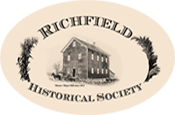Messer/Mayer Mill Improvements
Almost Lost--
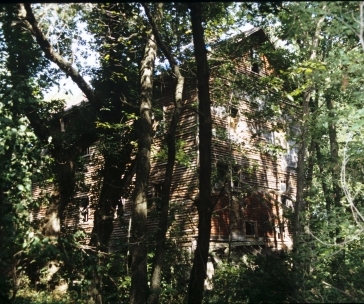 What
is that old rundown building tucked back in the woods off Pleasant Hill
Road in Richfield, Wisconsin? Raccoons probably have a heyday in there.
It sure looks like a fire hazard. However, the Town of Richfield and a
group of Town residents didn't feel that way about the Messer/Mayer
Mill. The Town purchased the Mill and Homestead property in 1998. The
Town Chairman, Ralph Schulteis, said, "It would be shame to let this
go." A local newspaper stated "By buying Mayer's Mill, Richfield
preserves a piece of Town's past."
What
is that old rundown building tucked back in the woods off Pleasant Hill
Road in Richfield, Wisconsin? Raccoons probably have a heyday in there.
It sure looks like a fire hazard. However, the Town of Richfield and a
group of Town residents didn't feel that way about the Messer/Mayer
Mill. The Town purchased the Mill and Homestead property in 1998. The
Town Chairman, Ralph Schulteis, said, "It would be shame to let this
go." A local newspaper stated "By buying Mayer's Mill, Richfield
preserves a piece of Town's past."
Preservation Begins--
Once the property was purchased, the newly formed Richfield Historical
Society (RHS) took over the restoration and maintenance of all the
buildings on the Messer/Mayer Homestead. The historic buildings are all
there—just like they were when the last mill operator, George Mayer,
left the property in 1971.
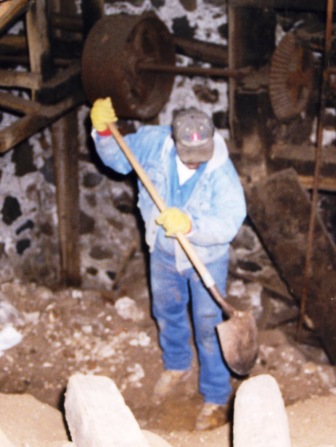 What
has been done to the Mill by the Society with its "Can Do" attitude
since the property was purchased? The list is pretty lengthy. The first
order of business was to get rid of the branches that had grown right
through the roof. Handel’s Tree Service donated their services to
tackle that problem. Once that was completed, Foresters Roofing donated
and placed a huge blue tarp over the roof to cover the holes left by
the branches that had been removed.
What
has been done to the Mill by the Society with its "Can Do" attitude
since the property was purchased? The list is pretty lengthy. The first
order of business was to get rid of the branches that had grown right
through the roof. Handel’s Tree Service donated their services to
tackle that problem. Once that was completed, Foresters Roofing donated
and placed a huge blue tarp over the roof to cover the holes left by
the branches that had been removed.
Volunteers at Work--
The mill and the other buildings on the
property were cleaned out—taking away all the debris that had
accumulated over the years. Dan Wittenberger 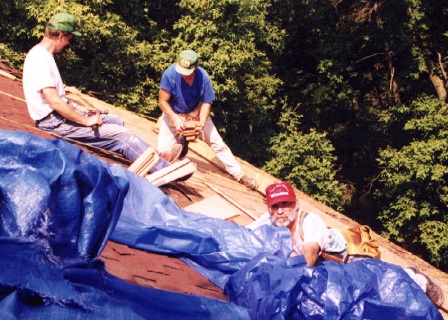 and
a crew of RHS volunteers removed the old rotted material and replaced
it with cedar shingles which matched the character of the mill. If you
would visit the 3rd floor of the Mill today, you would not recognize
that the roof had been replaced.
and
a crew of RHS volunteers removed the old rotted material and replaced
it with cedar shingles which matched the character of the mill. If you
would visit the 3rd floor of the Mill today, you would not recognize
that the roof had been replaced.
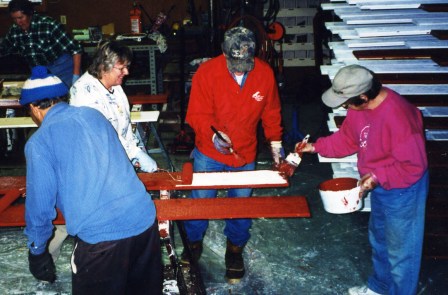 Every piece of the siding on the Mill had to be replaced. Before it
could be replaced, it had to be painted. So, the Society organized
'painting parties.' The long pieces of siding were placed on a
customized rack and the coat of primer plus two coats of Mill red paint
meticulously covered each piece. Wonder if the volunteer painters still
have any of those clothes that probably had more red paint on them than
was on the siding. Those 'painting parties' were a lot of fun and
helped bond the Society members. As the siding was painted,
Every piece of the siding on the Mill had to be replaced. Before it
could be replaced, it had to be painted. So, the Society organized
'painting parties.' The long pieces of siding were placed on a
customized rack and the coat of primer plus two coats of Mill red paint
meticulously covered each piece. Wonder if the volunteer painters still
have any of those clothes that probably had more red paint on them than
was on the siding. Those 'painting parties' were a lot of fun and
helped bond the Society members. As the siding was painted,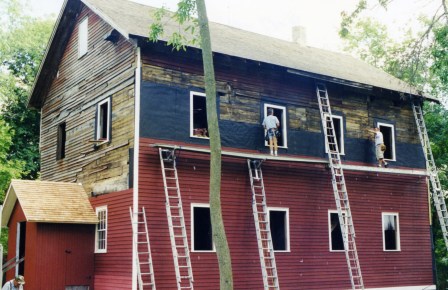 completed boards were installed on the Mill. This project took two years –2002 through 2004
completed boards were installed on the Mill. This project took two years –2002 through 2004
Because either the windows were broken or the frames were rotted, all 25 of the windows had to be rebuilt and the glass replaced. This was a painstaking job and required the skills of woodworkers. Fortunately, the Society had such talented volunteers who took on this task. Most of the glass was replaced with the old-fashioned type that has 'swirls' when you look through it—giving the mill an authentic look.
With the roof, windows, and siding all in place, the animals lost their happy home. The rain, sleet, and snow would no longer play havoc with the valuable original equipment inside the Mill--the millstones, sifting machines, hoppers, grain elevators, roller mills, and much more.
Inside Repairs--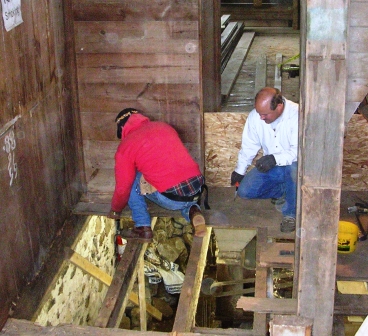
Work then turned to the inside of the Mill. In 2002, Bender Builders
from Beaver Dam, jacked up and straightened the interior of the Mill.
Because the roof had leaked for so many years, much of the flooring had
rotted. In 2003 and 2004, basswood boards were cut from the trees that
were taken down from the overgrown property. This lumber was used to
repair the 2nd and 3rd floors. Two stands of the roller mills (a newer
method of grinding grain) were refurbished. Additional repairs have
been made to the beams, joists, and flooring on the 3rd level. One of
the sifting machines has been reworked. A set of gravity elevators now
moves grain from floor to floor.
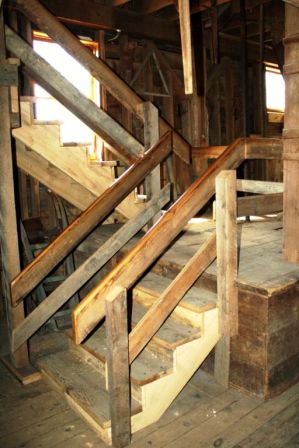
Many tours go through the Mill during the Events of the Society. There was always a bottleneck in getting visitors from the 2nd floor down to the 1st floor with only one set of stairs. This situation was remedied by putting in another flight of stairs so visitors can go up to the 2nd floor via one set of stairs but return to the 1st floor via the new set—much more efficient. The stairs were built to look as if they had always been there.
Power Sources--
Let’s
move back to the outside for further improvements. The water
chase which will eventually carry water into the Mill to power the
turbine was rebuilt as an Eagle Scout project. However, until approval and funds can be 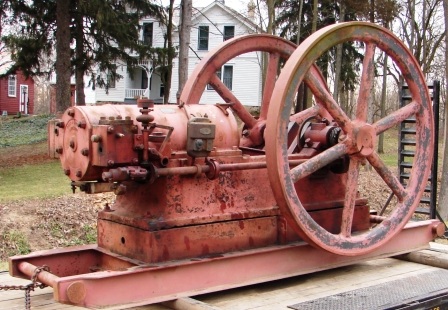 obtained
to reconstruct the dam for a mill pond, the Mill will need a different
power source. This will be a 1913 Superior gas engine very similar to
the one that once ran the Mill during some of its lifetime. This was
purchased in 2006. The front steps were moved to the west side and
steps were built on the east side to replicate the original look of the
front of the Mill.
obtained
to reconstruct the dam for a mill pond, the Mill will need a different
power source. This will be a 1913 Superior gas engine very similar to
the one that once ran the Mill during some of its lifetime. This was
purchased in 2006. The front steps were moved to the west side and
steps were built on the east side to replicate the original look of the
front of the Mill.
Restoring the Foundation--
As time took its toll on the limestone mortar and stone foundation,
large cracks were found and stones were falling out of place. After
over 150 years, this wasn't unexpected. Much consideration was given to
this situation, and in 2009 the foundation was stabilized by Marion
Restoration 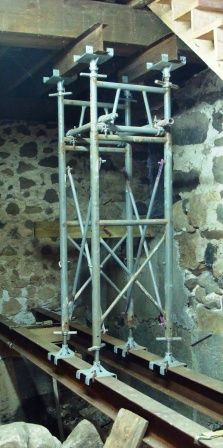 until
the funds could be raised to restore the foundation to pristine
condition. Because the entire building will shake when the millstones
will eventually turn, the foundation must be firm.
until
the funds could be raised to restore the foundation to pristine
condition. Because the entire building will shake when the millstones
will eventually turn, the foundation must be firm.
Finally, sufficient funds were raised to restore part of the foundation (Phase 1). In 2013, the northern basement wall and portions of the east and west walls were tuckpointed and repaired. One part of the west basement wall had to be rebuilt entirely. The remainder of the east and west walls as well as the very tall south wall still needs to be rebuilt. Fundraising efforts continue at this time to finance that very expensive project.
During Phase 1 of the foundation restoration, the basement stairs had been dismantled. This stairway has been rebuilt in a much sturdier fashion. Also, a door opening was added to the basement so tours can now see that portion of this Mill.
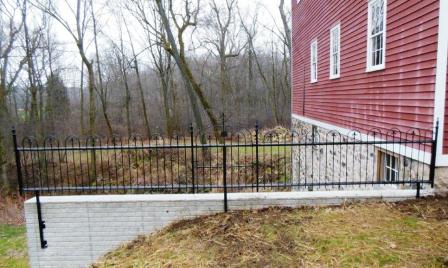
During Phase 2 of the restoration, a path leading to the basement was made, a door was hand built for the opening, a retaining wall was put in place with an attractive safety railing across the top.
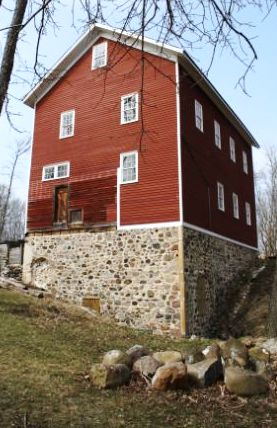 Phase 3: the foundation of the Messer/Mayer Mill has been completely restored and should last another 150 years. Also, the Leffel turbine was dug from its muddy grave and will be restored to its glory by a volunteer. A Big Thank You to everyone who donated funds over the past 7 years to make this foundation restoration possible.
Phase 3: the foundation of the Messer/Mayer Mill has been completely restored and should last another 150 years. Also, the Leffel turbine was dug from its muddy grave and will be restored to its glory by a volunteer. A Big Thank You to everyone who donated funds over the past 7 years to make this foundation restoration possible.
What's Next--
The next step is to rebuild the engine shed which will house the gasoline engine. This engine will provide the power to turn the millstones until water can once again flow down the raceway. All of the shafting needs to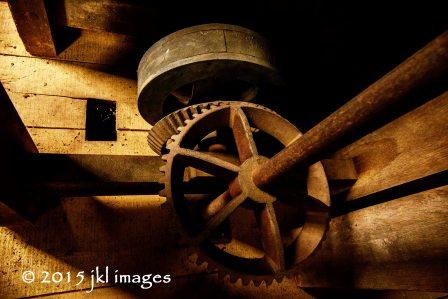 be connected so the large millstones can once again make
wheat into flour. Other machinery inside the Mill will need refurbishing. The task to "Get the Mill Grinding" is far from over. Click here to find out how you can help continue with this restoration.
be connected so the large millstones can once again make
wheat into flour. Other machinery inside the Mill will need refurbishing. The task to "Get the Mill Grinding" is far from over. Click here to find out how you can help continue with this restoration.
